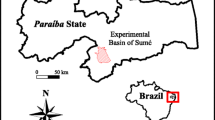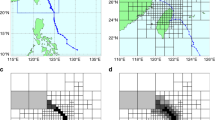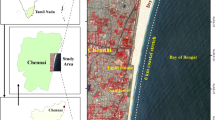Abstract
In this study, we present a semi-automatic procedure using Neural Networks—Self Organizing Map—and Shuttle Radar Topography Mission DEMs to characterize morphometric features of the landscape in the Man and Biosphere Reserve “Eastern Carpathians”. We investigate specially the effect of two resolutions, SIR-C with 3 arc seconds and X-SAR with 1 arc second for morphometric feature identification. Specifically we investigate how the SRTM/C band data with 30 m interpolated grid, corresponding to SRTM/X band 30 m, affect the morphometric characterization and topography derivatives. To reduce misregistration between the DEMs, spatial co-registration was performed and a RMSE of 0.48 pixel was achieved. Morphometric parameters such as slope, maximum curvature, minimum curvature and cross-sectional curvature are derived using a bivariate quadratic approximation on 90 m, 30 m and interpolated 30 m DEMs. Self Organizing Map (SOM) is used for the classification of morphometric parameters into ten exclusive and exhaustive classes. These classes were analyzed as morphometric features such as ridge, channel, crest line and planar for all data sets based on feature space (scatter plot), morphometric signatures and 3D inspection of the area. The map quality is analyzed by oblique views with contour lines overlaid. Using the X band DEM with 30 m grid as benchmark, a change detection technique was used to quantify differences in morphometric features and to assess the scale effect going from a 90 m (C-band) DEM to an interpolated 30 m DEM. The same procedure is used to study the effect of different resolutions on morphometric features. Morphometric parameters were computed by a moving window size 5 × 5 (corresponding to 450 m on the ground) over SRTM- 90 m. To cover the same ground area, a moving window size of 15 × 15 is used for the 30 m DEM. The change analysis showed the amount of resolution dependency of morphometric features. Overall, the results showed that the introduced method is very useful for identification of morphometric features based on SRTM resolution. Decreasing the grid size from 90 m to 30 m reveals considerably more detailed information emphasizing local conditions. Comparison between results from DEM-30 m as reference data set and interpolated 30 m, showed a rate of change of 31.5% which is negligible. About 17% of this rate correspond to classes with mean slope > 10°. Of the morphometric parameters, the cross sectional curvature is most sensitive to DEM resolution. Increasing spatial resolution reduces the main constrains for morphometric analysis with SRTM 90 m data, such as unrealistic features and isolated single elements in the output map. So in case of lack of high resolution data, the SRTM 90 m data could be interpolated and used for further geomorphic analysis.










Similar content being viewed by others
References
Farr TG, Kobrick M (2000) Shuttle radar topography mission produces a wealth of data. Am Geophys Union EOS 81:583–585
Hancock GR et al (2006) A comparison of SRTM and high-resolution digital elevation models and their use in catchment geomorphology and hydrology: Australian examples. Earth Surf Processes Landf 31(11):1394–1412
Kaab A (2005) Combination of SRTM3 and repeat ASTER data for deriving alpine glacier flow velocities in the Bhutan Himalaya. Remote Sens Environ 94:463–474. doi:10.1016/j.rse.2004.11.003
Kellndorfer J et al (2004) Vegetation height estimation from shuttle radar topography mission and national elevation datasets. Remote Sens Environ 93:339–358. doi:10.1016/j.rse.2004.07.017
Miliaresis GC, Paraschou CVE (2005) Vertical accuracy of the SRTM DTED level 1 of Crete. Int J Appl Earth Observation Geoinformation 7:49–59. doi:10.1016/j.jag.2004.12.001
Rabus B et al (2003) The shuttle radar topography mission—a new class of digital elevation models acquired by spaceborne radar. ISPRS J Photogramm Remote Sens 57(4):241–262. doi:10.1016/S0924-2716(02)00124-7
Dikau R (1989) The application of a digital relief model to landform analysis in geomorphology. In: Raper J (ed) Three dimensional applications in geographical information systems. Taylor & Francis, London, pp 51–77
Adediran AO et al (2004) Computer-assisted discrimination of morphological units on north-central Crete (Greece) by applying multivariate statistics to local relief gradients. Geomorphology 58:357–370. doi:10.1016/j.geomorph.2003.07.024
Burrough PA, Van Gaans PFM, MacMillan RA (2000) High-resolution landform classification using fuzzy k-means. Fuzzy Sets Syst 113:37–52. doi:10.1016/S0165-0114(99)00011-1
Irvin BJ, Ventura SJ, Slater BK (1997) Fuzzy and isodata classification of landform elements from digital terrain data in Pleasant Valley, Wisconsin Geoderma. 77:37–154
Prima ODA et al (2006) Supervised landform classification of Northeast Honshu from DEM-derived thematic maps. Geomorphology 78(3–4):373–386. doi:10.1016/j.geomorph.2006.02.005
Hengl T, Rossiter DG (2003) Supervised landform classification to enhance and replace photo-interpretation in semi-detailed soil survey. Soil Sci Soc Am J 67:10–1822
Brown DG, Lusch DP, Duda KA (1998) Supervised classification of types of glaciated landscapes using digital elevation data. Geomorphology 21:233–250. doi:10.1016/S0169-555X(97)00063-9
Stepinski TF, Collier ML (2004) Extraction of Martian valley networks from digital topography. J Geophys Res 109
Stepinski TF, Vilalta R (2005) Digital topography models for Martian surfaces. IEEE Geosci Remote Sens Lett 2:260–264. doi:10.1109/LGRS.2005.848509
Evans IS (1972) General geomorphology, derivatives of altitude and descriptive statistics. In: Chorley RJ (ed) Spatial Analysis in Geomorphology. Methuen & Co. Ltd, London, pp 17–90
Crevenna AB et al (2005) Geomorphometric analysis for characterizing landforms in Morelos State, Mexico. Geomorphology 67(3–4):407–422. doi:10.1016/j.geomorph.2004.11.007
Ehsani AH, Quiel F (2008) Geomorphometric feature analysis using morphometric parameterization and artificial neural networks. Geomorphology 99(1–4):1–12. doi:10.1016/j.geomorph.2007.10.002
Miska L, Jan H (2005) Evaluation of current statistical approaches for predictive geomorphological mapping. Geomorphology 67(3–4):299–315. doi:10.1016/j.geomorph.2004.10.006
Sueli AM, Lima JO (2006) Comparing SOM neural network with Fuzzy c-means, K-means and traditional hierarchical clustering algorithms. Eur J Oper Res 174:1742–1759. doi:10.1016/j.ejor.2005.03.039
Cannon AJ, Whitfield PH (2002) Downscaling recent streamflow conditions in British Coulmbia, Canada using ensemble neural networks. J Hydrol (Amst) 259:136–151. doi:10.1016/S0022-1694(01)00581-9
Lek S, Guegan J (1999) Artificial neural networks as a tool in ecological modelling, an introduction. Ecol Modell 120:65–73. doi:10.1016/S0304-3800(99)00092-7
Zhang B, Govindaraju RS (2003) Geomorphology-based artificial neural networks (GANNs) for estimation of direct runoff over watersheds. J Hydrol (Amst) 273(1–4):18–34. doi:10.1016/S0022-1694(02)00313-X
Iwahashi J, Pike RJ (2007) Automated classifications of topography from DEMs by an unsupervised nested-means algorithm and a three-part geometric signature. Geomorphology 86:409–440. doi:10.1016/j.geomorph.2006.09.012
Suganthan P (2001) Pattern classification using multiple hierarchical overlapped self-organising maps. Pattern Recognit 34(11):2173–2179. doi:10.1016/S0031-3203(00)00147-3
Kiang MY (2001) Extending the Kohonen self-organizing map networks for clustering analysis. Comput Stat Data Anal 38(2):161–180. doi:10.1016/S0167-9473(01)00040-8
Ehsani AH, Quiel F (2008) Application of self organizing maps and SRTM data to charecterize Yardangs in the Lut Desert, Iran. Remote Sens Environ 112(7):3284–3294. doi:10.1016/j.rse.2008.04.007
Manikopoulos CN (1993) Finite state vector quantisation with neural network classification of states. IEEE Proc-F 140(3):153–161
Bimbo AD, Landi L, Santini S (1993) Three-dimensional planar-faced object classification with Kohonen maps. Opt. Eng 32(6):1222–1234. doi:10.1117/12.134188
Sabourin M, Mitiche A (1993) Modeling and classification of shape using a Kohonen associative memory with selective multiresolution. Neural Netw 6:275–283. doi:10.1016/0893-6080(93)90021-N
Takahashi T et al (2001) Self-organization of place cells and reward-based navigation for a mobile robot. in 8th International Conference on Neural Information Processing. Shanghai (China).
Walter JA, Schulten KJ (1993) Implementation of self-organizing neural networks for visuo-motor control of an industrial robot. IEEE Trans Neural Netw 4:86–95. doi:10.1109/72.182698
Mather PM, Tso B, Koch M (1998) An evaluation of Landsat TM spectral data and SAR-derived textural information for lithological discrimination in the Red Sea Hills, Sudan. Int J Remote Sens 19(4):587–604. doi:10.1080/014311698215874
Özkan C, Sunar Erbek F (2005) Comparing feature extraction techniques for urban land-use classification. Int J Remote Sens 26(4):747–757. doi:10.1080/01431160512331316793
Ehsani AH, Quiel F (2009) A semi-automatic method for analysis of landscape elements using shuttle radar topography mission and landsat ETM+ data. Comput Geosci 35:373–389
Penn BS (2005) Using self-organizing maps to visualize high-dimensional data. Computers & Geosciences 31(5):531–544
Penn BS, Livo KE (2001) Using AVIRIS images to map geologic signatures of copper flat porphyry copper deposit, Hillsboro, New Mexico. in 10th JPL workshop on Airborne Earth Science Workshop. Jet Propulsion Laboratory, California Institute of Technology
Deboeck GJ (1998) Financial applications of self-organizing maps. Electronic Newsletter American Heuristics, Inc
Deboeck GJ, Kohonen T (1998) Visual explorations in finance with self-organizing maps. Springer-Finance, London, p 205
Bigus JP (1996) Data mining with neural networks. McGraw-Hill, New York, p 220
Koua EL, MacEachren A, Kraak MJ (2006) Evaluating the usability of visualization methods in an exploratory geovisualization environment. Int J Geogr Inf Sci 20:425–448
Vesanto J, Alhoniemi E (2000) Clustering of the self-organizing map. IEEE Trans Neural Netw 11:14
Penn BS (2002) Using self-organizing maps, histograms, and standard deviation to detect anomalies in hyperspectral imagery data. In: 5th International Airborne Remote Sensing Conference. Miami, Florida
Penn BS (2002) Using self-organizing maps for anomaly detection in hyperspectral imagery. in IEEE Aerospace Conference. Big Sky, MT
Penn BS, Wolboldt MW (2003) Methods for detecting anomalies in AVIRIS imagery. In: 12th Jet Propulsion Laboratory Airborne Earth Science Workshop. Pasadena, California
Duda T, Canty M (2002) Unsupervised classification of satellite imagery: choosing a good algorithm. Int J Remote Sens 23(11):2193–2212
Jianwen M, Bagan H (2005) Land-use classification using ASTER data and self-organized neural networks. Int J Appl Earth Obs and Geo 7:183–188
Fisher P, Wood J, Cheng T (2004) Where is Helvellyn? Fuzziness of multiscale landscape morphometry. Trans Inst Br Geogr 29:106–128
Pike RJ (2000) Geomorphology—Diversity in quantitative surface analysis. Prog Phys Geogr 24:1–20
Wood J (1996) The geomorphological characterization of digital elevation models. in Department of Geography. University of Leicester, Leicester, UK
Evans IS (2003) Scale specific landforms and aspects of the land surface. In: Evans IS, et al (eds) Concept sand modeling in geomorphology: International perspectives, pp 61–84
Tate N, Wood J (2001) Fractals and scale dependencies in topography. In: Tate N, Atkinson P (eds) Modelling scale in geographical information science. Chichester, Wiley, pp 35–51
Walsh SJ, Butler DR, Malanson G (1998) An overview of scale, pattern, process relationships in geomorphology: a remote sensing and GIS perspective. Geomorphology 21(3–4):183–205
Wood J (1999) Visualization of scale dependencies in the surface models. In: 19th International Cartographic Association Annual Conference. Ottawa, http://www.soi.city.ac.uk/~jwo/ica99
Wood J (2002) Visualizing the structure and scale dependency of landscapes. In: Fisher P, Unwin D (eds) Virtual reality in geography. Taylor & Francis, London, pp 163–174
Wilson JP, Gallant JC (2000) Terrain analysis: Principles and applications. Wiley, New York, p 479
Wood J (1996) Scale-based characterisation of digital elevation models. In: Parker D (ed) Innovations in GIS 3: Selected papers from the third national conference on GIS Research UK (GISUK). Taylor & Francis, London, pp 163–175
Deng Y, Wilson JP, Bauer BO (2007) DEM resolution dependencies of terrain attributes across a landscape. Int J Geogr Inf Sci 21:187–213
Deng Y, Wilson JP, Gallant JC (2007) Terrain analysis. In: Wilson JP, Fotheringham AS (eds) The handbook of geographic information science. USA, Blackwell
Schoorl JM, Sonneveld MPW, Veldkamp A (2000) Three-dimensional landscape process modeling: the effect of DEM resolution. Earth Surf Processes Landf 25:1025–1034
Sorensen R, Seibert J (2007) Effects of DEM resolution on the calculation of topographical indices: TWI and its components. J Hydrol 347(1–2):79–89
Thompson JA, Bell JC, Butler CA (2001) Digital elevation model resolution: effects on terrain attribute calculation and quantitative soil-landscape modeling. Geoderma 100(1–2):67–89
Wu W et al (2008) Assessing effects of digital elevation model resolutions on soil-landscape correlations in a hilly area. Agriculture, Ecosystems & Environment. 126(3–4):209–216
Smith MP et al (2006) The effects of DEM resolution and neighborhood size on digital soil survey. Geoderma 137(1–2):58–69
Ziadat FM (2007) Effect of Contour Intervals and Grid Cell Size on the Accuracy of DEMs and Slope Derivatives. Trans GIS 11(1):67–81
Valeriano MM et al (2006) Modeling small watersheds in Brazilian Amazonia with shuttle radar topographic mission-90 m data. Comput Geosci 32(8):1169–1181
Denisiuk Z, Stoyko SM (2000) The East Carpathian biosphere reserve (Poland, Slovakia, Ukraine). In: Breymeyer A, Dabrowski P (eds) Biosphere reserves on borders. Warsaw, UNESCO
Kuemmerle T et al (2006) Cross-border comparison of land cover and landscape pattern in Eastern Europe using a hybrid classification technique. Remote Sens Environ 103(4):449–464
Jarvis A et al (2006) Hole-filled SRTM for the globe Version 3, available from the CGIAR-CSI SRTM 90m Database: http://srtm.csi.cgiar.org
GRASS Development Team (2006) Geographic resources analysis support system (GRASS), GNU General Public License. Eletronic document. http://grass.itc.it
Kohonen T (2001) Self organizing maps. New York, Springer, p 501
Pike RJ (2001) Topographic fragments of geomorphometry, GIS, DEMs. in 5th Intl. Conf. Geomorph, DEMs, Geomorphology. GIS Assoc, Chuo University, Tokyo, Japan
Acknowledgement
We are grateful to the Swedish Institute for funding all travel expenses in the framework of the Visby program. We like to thank all our colleagues especially Docent Ivan Kruhlov, Department of Physical Geography, Ivan Franko University in Lvov, Ukraine and Dr. Mieczyslaw Sobik, Institute of Geography and Regional Development, University Wroclaw, Poland for interesting discussions and for providing facilities and support.
Author information
Authors and Affiliations
Corresponding author
Rights and permissions
About this article
Cite this article
Ehsani, A.H., Quiel, F. & Malekian, A. Effect of SRTM resolution on morphometric feature identification using neural network—self organizing map. Geoinformatica 14, 405–424 (2010). https://doi.org/10.1007/s10707-009-0085-4
Received:
Revised:
Accepted:
Published:
Issue Date:
DOI: https://doi.org/10.1007/s10707-009-0085-4




